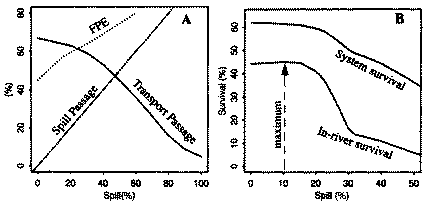![]()
For several years, salmon advocates have advocated that the federal projects be run so as to achieve 80% "Fish Passage Efficiency". Most people think this means that the project passes 80% of the fish, or, conversely, that 20% never make it past the dam and die. Luckily, that isn’t what Fish Passage Efficiency means.
One of the clever tactics used by the salmon advocates is the adoption of terminology that is misleading. "Fish Passage Efficiency" is one of the "best" of these ploys. Fish Passage Efficiency means the percentage of fish that pass by a project by a means other than through the turbines. Thus, a Fish Passage Efficiency (FPE) of 80% would mean that 20% of the salmon die only if 100% of the fish died in the turbines.
As set forth in Chapter 4, the most recent studies suggest that turbines only cause about 5% direct mortality. Even if the turbines killed 10% of the fish, which is doubtful, survival through a dam would be 98% at 80% FPE. At 70% FPE, survival would be 97%. The misleading "Fish Passage Efficiency" terminology, however, produces media accounts of "high death rates" because media representatives assume that FPE is the "percent of migrating smolts to safely traverse each dam".15
What matters to salmon, however, is survival, not FPE. The relationship between FPE and survival is not simple, and varies project by project. Here is a graph prepared with the CRiSP computer model for Little Goose Dam that shows the relationship between the percent of fish spilled, the percent transported, Fish Passage Efficiency, and ultimate percent survival:

Figure 25: FPE vs. Survival16
It is clear that pursuing increased FPE does not make much sense as a goal in itself, since both system survival (transported and untransported fish) and in-river survival drop with higher FPE. Even though fewer fish go through the turbines with higher FPE, more are lost to the gas supersaturation and other injuries associated with spill, including decreased transportation.
Higher FPE, however, is the formal goal of federal, state and tribal harvest managers, not higher survival. The Bonneville Power Administration continues to advise the fishery managers that “survival across the concrete may be a better criterion than FPE”,17 and the fishery managers continue to ignore BPA.
Unless you were trying to reduce power production for the sake of reducing power production, why wouldn’t you simply adopt a goal of maximizing survival? I don’t know, but I do know that fish advocates used to have a goal of improving survival; after it was largely met, they began to focus on goals that seem to have no purpose but to make dams uneconomical.
FPE is a highly politicized number. The Corps of Engineers has spent hundreds of millions of dollars putting in traveling screens in front of the turbine intake to guide fish away from the turbines. The Corps continually evaluates their efficacy. The most recent studies have suggested that travelling screens on the Snake projects can guide 80% of the yearling juveniles away from the turbines. Thus, a project can have 80% FPE with no spill at all. Dam opponents cite older studies showing that FPEs, based on older configurations, were much lower.
Beginning in the late 1980s, the Corps of Engineers had pursued fish passage goals that aimed for 70% FPE. Higher FPE targets required more spill, which would cause levels of total dissolved gas to rise too high. Beginning in the 1990s, the state fishery agencies and tribes no longer worried about dissolved gas.
Their basic rationale was that years with high flow and spill tended to be associated with more returning adults. Thus spill must be good. No one pointed out that the fishery managers were already claiming that the flow itself caused higher survival, through reduced travel time, or some other means they could never really explain. No one challenged the fishery managers to distinguish positive effects of spill from other factors associated with high flow and spill years, such as better ocean conditions.
15 See, e.g., "Fish passage projects under scrutiny", The Northwest Salmon Recovery Report, Oct. 24, 1997, at 10. This article, in a newsletter focused on salmon recovery, actually confuses FGE (Fish Guidance Efficiency) with Fish Passage Efficiency (FPE). FGE is the percentage of smolts that a particular bypass system, like screens, will catch. It has even less of a relationship to survival than FPE does.
16 From J. Anderson, “Impact of 1995 River Operations on Smolt Survival”, Sept. 7, 1995, at 7 (Figure 7).
17 BPA, “Interim Research, Monitoring, and Evaluation Program to Support the FCRPS Biological Opinion and Recovery Plan”, at 29 n.5 (Nov. 15, 1995 Draft).
This Web page was created using a Trial Version of HTML Transit 3.0.